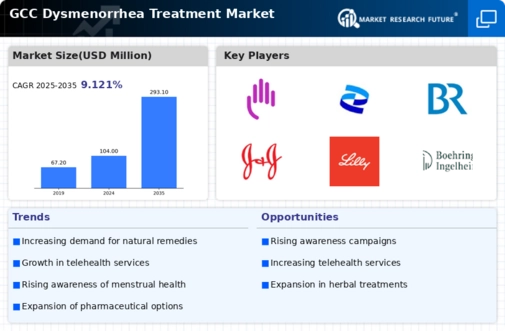The GCC Dysmenorrhea Treatment Market is characterized by a substantial competitive landscape where various pharmaceutical companies strive to provide effective solutions for managing menstrual pain. The market is witnessing a surge in demand for both over-the-counter and prescription medications, driving companies to innovate and expand their product offerings. Key factors influencing competition include the prevalence of dysmenorrhea among women in the GCC region, the increasing awareness of menstrual health, and the favorable regulatory environment supporting the approval of new treatments.
As players in the market focus on enhancing their product efficacy and improving patient accessibility, a trend towards developing combination therapies and novel formulations is becoming increasingly prominent. Furthermore, the rise of e-commerce platforms is reshaping distribution channels, allowing companies to reach a broader audience and cater to the unmet needs of patients.GlaxoSmithKline has established a noteworthy presence in the GCC Dysmenorrhea Treatment Market, leveraging its extensive experience in the pharmaceutical sector to offer an array of products specifically aimed at alleviating menstrual pain.
The company benefits from its strong brand recognition and reputation for quality, which bolsters consumer trust in its offerings. GlaxoSmithKline focuses on research and development to innovate and optimize its treatment options, thus adapting to the evolving healthcare landscape in the GCC. The company also emphasizes effective marketing strategies that resonate with local customers, allowing it to strengthen its market share.
This tailored approach to the GCC region enhances its competitiveness and relevance in addressing women's health issues in the area.HoffmannLa Roche is also a significant player in the GCC Dysmenorrhea Treatment Market, presenting a diverse portfolio of pharmaceutical products designed to address not only dysmenorrhea but also related conditions.
The company is recognized for its commitment to innovation and has made substantial investments in research and development to enhance the effectiveness and safety of its treatments. HoffmannLa Roche's market presence is supported by strategic partnerships and collaborations within the GCC healthcare sector, enabling them to gain insights into local market dynamics and customer preferences. Their key products often include nonsteroidal anti-inflammatory drugs and hormonal therapies, which are well-regarded for their efficacy in managing menstrual pain.
Additionally, HoffmannLa Roche's strengths lie in its strong distribution network and focused marketing efforts that emphasize education on menstrual health, which further enhances its visibility and market penetration in the GCC region. The company's strategic acquisitions in recent years have bolstered its portfolio and positioning within the market, allowing for a more comprehensive approach to women's health management in this demographic.























Leave a Comment